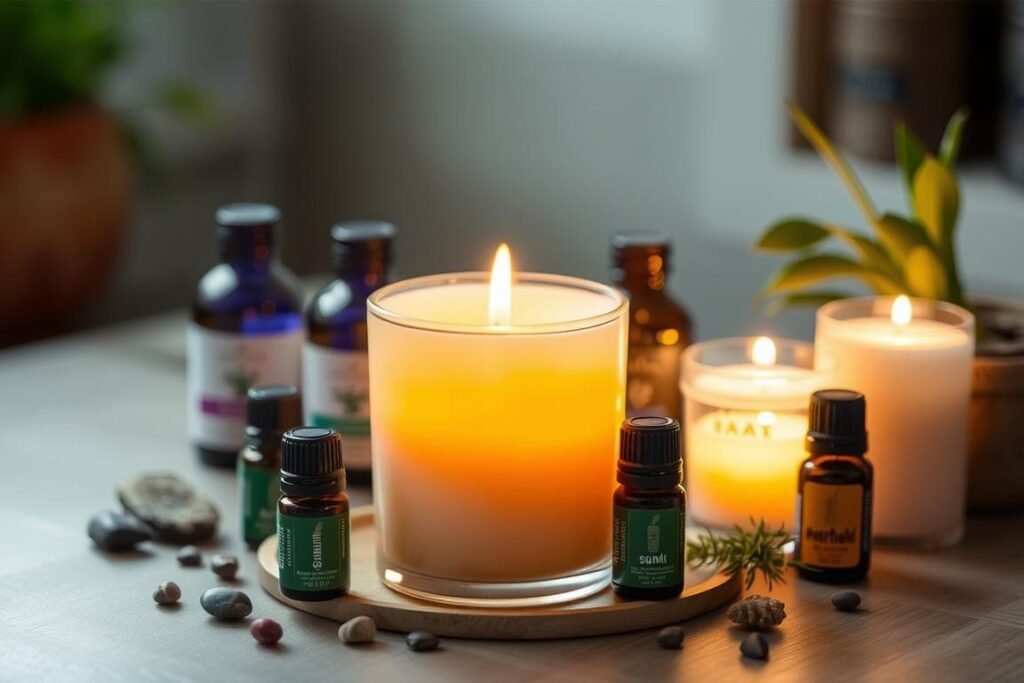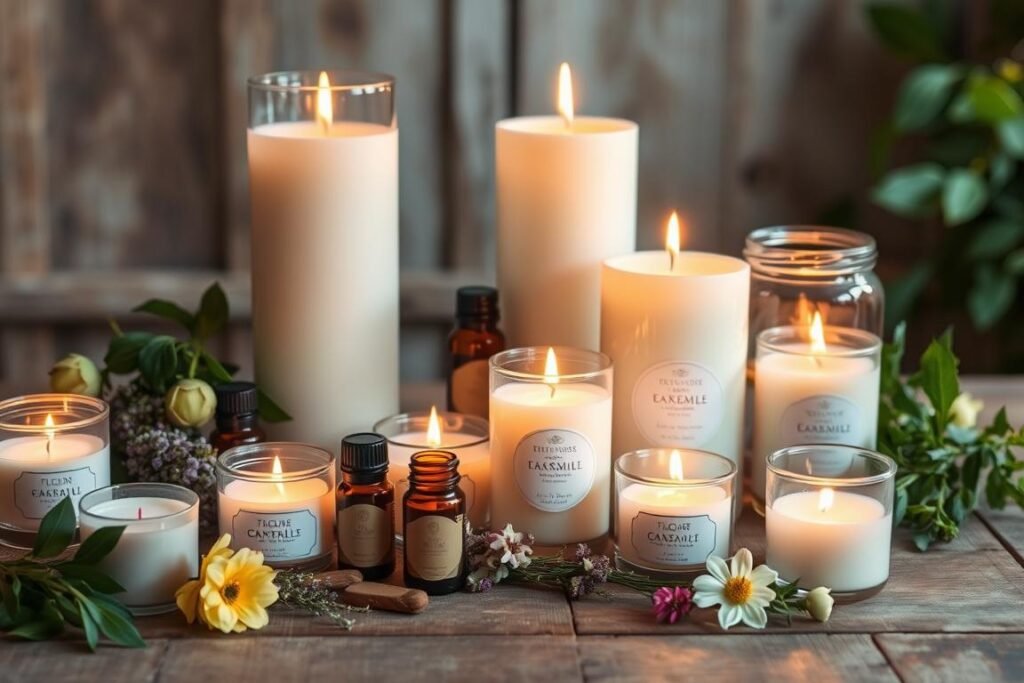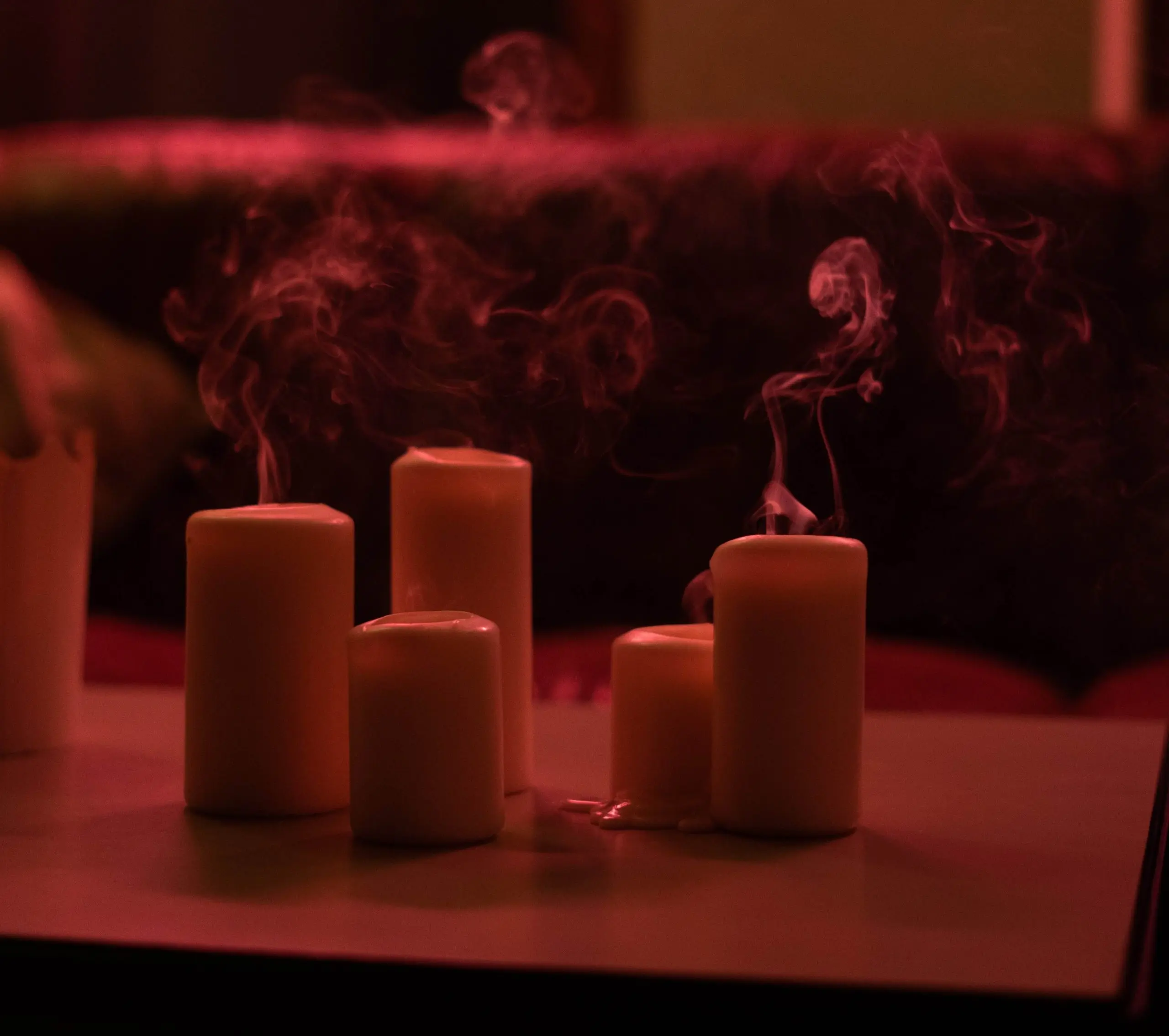Essential oils are getting more popular for their health benefits and use in scented candles. But, is it safe to burn them in candles? This guide will look into the risks and benefits of using essential oils in candles. We’ll give you the info you need to decide wisely.
Essential oils are strong plant extracts used in aromatherapy and natural products. They can help relax or improve mood. But, burning them in candles can harm their benefits. The heat can destroy their properties and release harmful substances.
Key Takeaways
- Essential oils can lose their aromatherapy benefits when burned in candles due to the high temperatures involved.
- Burning essential oils in candles can release toxic compounds, making them potentially harmful for health and the environment.
- The scent throw of essential oils in candles is often lower compared to synthetic fragrance oils.
- Certain wax types, such as beeswax, may be more compatible with essential oils than others, like paraffin or genetically modified soy wax.
- Proper temperature control and dilution ratios are crucial when using essential oils in candle-making.
Understanding Essential Oils and Their Properties
Essential oils are complex, volatile compounds from plants. They differ from synthetic fragrance oils. These oils have unique chemical makeup, including terpenes and phenols. This makes them aromatic and potentially therapeutic.
However, their molecular structure changes with heat. This is because candle burning involves intense heat.
What Makes Essential Oils Different from Fragrance Oils
Essential oils come from plants, unlike synthetic fragrance oils. They are extracted through steam distillation or cold-pressing. This natural process keeps their molecular structure intact.
This results in a more nuanced and potent aroma. Essential oils offer a wide range of potential therapeutic benefits. They are popular for aromatherapy and natural skincare.
Chemical Composition and Volatility
Essential oils have a mix of chemical compounds like terpenes and phenols. These contribute to their scent and potential benefits. They are highly volatile, meaning they can evaporate or change with heat, light, or air.
This volatility is key when using essential oils in candles. The burning process can affect their integrity and performance.
Temperature Sensitivity of Essential Oils
Essential oils are sensitive to temperature. Certain oils, like sandalwood, patchouli, and ylang-ylang, have higher flash points. They are less volatile and better for candle-making.
However, many oils may release harmful compounds or lose their scent at high temperatures. Knowing the temperature needs and risks is crucial for safe and effective candle-making.
| Wax Type | Characteristics | Compatibility with Essential Oils |
|---|---|---|
| Soy Wax | Eco-friendly, clean-burning, good color and fragrance retention | Suitable, with recommended essential oil ratio of 6-10% |
| Beeswax | Air-purifying properties, longer burn times, subtle sweet fragrance | Suitable, with recommended essential oil ratio of 6-10% |
| Paraffin Wax | Excellent scent throw, but may release harmful toxins when burned | Less recommended due to potential health and environmental concerns |
| Palm Wax | Unique crystalline patterns, firm texture, sustainable sourcing | Suitable, with recommended essential oil ratio of 6-10% |
“Certain essential oils like sandalwood, patchouli, and ylang-ylang have higher flash points and are less volatile, making them suitable for candle making.”
Is it safe to burn essential oils in candles?
Burning essential oils in candles is a complex topic. Essential oils are natural but can become unstable and lose their benefits when heated. The volatility of essential oils also means they may not provide a consistent scent in candles. Some essential oils can even increase soot production, which is a concern.
But, when used correctly, essential oils can be safely added to candles. They offer natural fragrances without synthetic chemicals found in some commercial candles. It’s important to know the specific properties and safety considerations of each essential oil before making candles.
Risks of Burning Essential Oils in Candles
- Essential oils are highly volatile, evaporating easily, making them unstable for use in candles.
- Some essential oils can increase soot production, which can be a health and environmental concern.
- Burning essential oils may cause them to lose their therapeutic properties or even become toxic.
Potential Benefits of Using Essential Oils in Candles
- Provide natural, aromatic fragrances without synthetic chemicals.
- Offer potential aromatherapy benefits when used in appropriate quantities.
- Contribute to a more eco-friendly and sustainable candle-making process.
The safety of burning essential oils in candles depends on the specific oils used and the candle-making process. It also depends on following proper safety guidelines. By understanding the risks and benefits, candle enthusiasts can make informed choices. They can enjoy the natural fragrance and potential wellness benefits of essential oil-infused candles.
“Essential oils can be unsafe to use in candles as they break down under heat, can be extremely flammable, and some may become toxic when burned.”

Common Types of Candle Waxes and Their Compatibility
Choosing the right wax is key in candle making. It affects how well the candle works and how safe it is with essential oils. Each wax type has its own special qualities that change the candle’s quality, smell, and how long it burns.
Soy Wax vs. Beeswax for Essential Oil Candles
Soy wax is a favorite for essential oil candles because it burns clean and smells great. Soy wax is eco-friendly and made from renewable sources, which green consumers like. Beeswax, on the other hand, has a natural scent and is good for indoor use because it burns cleanly without harmful pollutants.
Paraffin and Other Wax Options
Paraffin wax is cheap and widely used in candle making. But, it can release harmful toxins when burned, which is a drawback for essential oil candles. Other waxes like palm wax, gel wax, and rapeseed wax have their own benefits, such as looking crystalline, burning longer, and working well with essential oils.
Wax Temperature Requirements
The temperature when adding wax to essential oils is very important. It should be between 120°F and 180°F. This ensures the wax melts right and the essential oils mix in well, making a great candle.
| Wax Type | Melting Point | Fragrance Throw | Burn Time | Environmental Impact |
|---|---|---|---|---|
| Paraffin | 145-165°F | Excellent | Average | Lower |
| Soy | 120-140°F | Good | Longer | Higher |
| Beeswax | 145-155°F | Subtle | Longer | Higher |
| Coconut | 165-195°F | Excellent | Longer | Higher |
The type of candle wax used can greatly affect the candle’s performance and safety. It influences the smell, burn time, and environmental impact. Knowing the special qualities of each wax is key to making high-quality, safe, and appealing essential oil candles for different tastes.

Best Essential Oils for Candle Making
Not all essential oils are the same when making candles. Some oils work better than others because of their special properties. Oils like sandalwood, patchouli, and ylang-ylang are great for candles. They don’t evaporate as much during making.
Other oils, like lavender, rosemary, and vanilla, have a strong scent throw. This means they can fill a room with their smell. When mixing oils, it’s important to think about how they smell together. This helps create a nice and balanced scent.
| Essential Oil | Cold Throw | Hot Throw | Discoloration | Approval |
|---|---|---|---|---|
| Lavender | Very strong | Very strong | No | Approved |
| Patchouli | Very strong | Strong | Turned yellow | Approved |
| Egyptian Geranium | Strong with smooth scent | Strong with smooth scent | No | Approved |
| Organic Ylang Ylang | Strong | Strong with slight shift in scent notes | Very minimal yellow | Approved |
| Cedarwood | Strong | Strong with slight shift in scent notes | Very minimal yellow | Approved |
The quality of essential oils is key for candles. They might cost more than fragrance oils, but their natural scent is worth it. For a budget-friendly option, essential oil blends for candles offer a great smell.
“Essential oils can transform a simple candle into a truly immersive and therapeutic experience.”
Scientific Research on Essential Oil Candle Safety
Candles, including those with essential oils, have been studied a lot. Some worry about harmful chemicals released when they burn. But, research shows that well-made essential oil candles are safe and fun for our homes.
Studies on VOC Emissions
Research says candles, with or without essential oils, release some chemicals. But, most of these are like things we find outside and aren’t bad. The government sets rules to make sure these chemicals are safe.
Health Impact Research
Studies show that essential oil candles are mostly safe if used right. Good quality candles and fresh air help keep them safe. But, people with allergies or breathing problems should be careful.
Environmental Considerations
Looking at the environment, wax types and air-purifying oils are studied. Beeswax, paraffin, and plant-based waxes break down easily. Oils like lemon and eucalyptus might clean the air when they’re released.
In summary, science backs up the safety of essential oil candles. They’re safe if we use them right and choose good materials. Still, we should think about our own health and air when using them.
Conclusion
Essential oils can be safely used in candles if done right. It’s important to think about the oil’s properties, how it works with wax, and the right mix. The safety of essential oil candles also depends on the quality of ingredients and how they’re used.
When made and used correctly, these candles offer a natural scent alternative. They can also bring aromatherapy benefits. But, it’s key to know your own sensitivities and follow guidelines for safe candle use.
Choosing high-quality essential oils and the right wax is crucial. Following safety rules is also important. This way, both makers and users can enjoy the natural scents safely.
Essential oil candles can make your space more relaxing and healthy. By following essential oil candle guidelines and being careful, you can enjoy aromatherapy safely. This makes candle burning a great way to add wellness to your daily life.
FAQ
What makes essential oils different from fragrance oils?
How does the chemical composition and volatility of essential oils affect their use in candles?
Is it safe to burn essential oils in candles?
What are the different types of candle waxes and their compatibility with essential oils?
Which essential oils are best suited for candle making?
What does the scientific research say about the safety of essential oil candles?
Source Links
- https://soycandlemakingtime.com/can-i-use-essential-oils-in-soy-candles/ – Can I use Essential Oils in Soy Candles-Is it Safe? – Learn How To Make Soy Candles at Home
- https://drcourtneykahla.com/candles-essential-oils-and-diffusers/ – candles, essential oils, and diffusers
- https://www.rockymountainoils.com/blogs/essential-oil-basics/can-you-put-essential-oils-in-candles?srsltid=AfmBOor1_SuQB_QWOHnwXiNmLGvNgfK3FK1jHrIQ7XCpkfqXtST2TG5O – Can You Put Essential Oils in Candle?
- https://www.terre-de-bougies.com/en/blogs/news/oils-essentials-candles – The Dangers of Essential Oils in Candles
- https://www.greenamerica.org/toxic-candles – Avoid Harmful Gases with Non-Toxic Candle Alternatives
- https://www.flickeringferncandle.com/blogs/news/essential-oils-vs-fragrance-oils-in-candles – Essential Oils vs. Fragrance Oils in Candles
- https://mykacandlesandmoulds.com/blogs/news/types-of-candle-wax?srsltid=AfmBOoo04w1gLY5INR8VN8lG6K5L5cM5EPBruAFQEUU2tobfMg90SV0k – The 7 Types of Candle Wax: Benefits and Uses Explained
- https://atomra.com/blogs/candle-sand-blog-101/complete-guide-to-candle-wax-types-issues-and-tips-for-perfect-burns – Complete Guide to Candle Wax: Types, Issues, and Tips for Perfect Burns
- https://aromaleap.com/blog/types-of-candle-wax/ – How to Choose the Right Types of Candle Wax? An Ultimate Guide
- https://www.edensgarden.com/blogs/news/can-you-use-essential-oils-for-candle-making?srsltid=AfmBOooVOKeYD0yVFG6l50dHAf8k-xsIkTtUj6SOK25LFxtxomHott9P – Can You Use Essential Oils For Candle Making?
- https://makesy.com/blogs/news/the-best-essential-oils-to-use-in-candles?srsltid=AfmBOoqv9jgZTUpe4kK2qlLB03NNALgBkXXMfqY2Gaf2xlVCuKBM3KKW – The Best Essential Oils to Use in Candles
- https://candles.org/faqs/ – FAQs – National Candle Association
- https://pmc.ncbi.nlm.nih.gov/articles/PMC10783381/ – The unknown risks of scented candles! what science has to say: an editorial
- https://oiltherapycentral.com/blogs/essential-oils/toxic-candles-essential-oils/ – Are Essential Oils Toxic in Candles – Oil Therapy Central
- https://www.rockymountainoils.com/blogs/essential-oil-basics/can-you-put-essential-oils-in-candles?srsltid=AfmBOopSFEimUnXwaZyzgFbJQn5xpO-Pg2lE66mNokcTrxZB5dQughVT – Can You Put Essential Oils in Candle?
- https://www.rockymountainoils.com/blogs/essential-oil-basics/can-you-burn-essential-oils?srsltid=AfmBOoroMDSiMjYmI-CLiTcyzj0l5gpmm–_fzhKaMlKWAChbmGA8ZDK – Can You Burn Essential Oils? – A Comprehensive Guide

